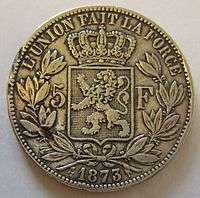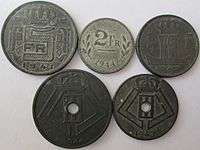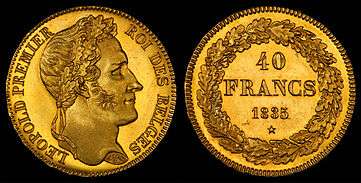Belgian franc
| Belgian franc | |
|---|---|
|
Belgische frank (Dutch) Franc belge (French) Belgischer Franken (German) | |
|
40 Belgian francs (1835) | |
| ISO 4217 | |
| Code | BEF |
| Denominations | |
| Subunit | |
| 1⁄100 |
Centime (French) Centiem (Dutch) Centime (German) |
| Plural |
Francs (French) Frank (Dutch)[lower-alpha 1] |
| Centime (French) Centiem (Dutch) Centime (German) |
Centimes (French) Centiemen (Dutch) |
| Symbol | fr. |
| Centime (French) Centiem (Dutch) Centime (German) | c. |
| Banknotes | 100, 200, 500, 1000, 2000, 10,000 fr. |
| Coins | 50 centimes, 1, 5, 20 & 50 francs |
| Demographics | |
| User(s) |
None, previously: |
| Issuance | |
| Central bank | National Bank of Belgium |
| Website |
www |
| Printer | National Bank of Belgium |
| Website |
www |
| Mint | National Bank of Belgium |
| Website |
www |
| Valuation | |
| ERM | |
| Since | 13 March 1979 |
| Fixed rate since | 31 December 1998 |
| Replaced by €, non cash | 1 January 1999 |
| Replaced by €, cash | 1 January 2002 |
| € = | 40.3399 francs |
|
This infobox shows the latest status before this currency was rendered obsolete. | |
The Belgian franc (French: Franc belge, Dutch: Belgische frank, German: Belgischer Franken) was the currency of the Kingdom of Belgium from 1832 until 2002 when the Euro was introduced. It was subdivided into 100 subunits, known as centimes (French), centiem (Dutch) or Centime (German).
History
The conquest of most of western Europe by revolutionary and Napoleonic France led to the French franc's wide circulation. In the Austrian Netherlands (the current Belgium), the franc replaced the kronenthaler. This was in turn replaced by the Dutch guilder when the United Kingdom of the Netherlands was formed.
Following independence from the Kingdom of the Netherlands, the new Kingdom of Belgium in 1832 adopted its own franc, equivalent to the French franc, followed by Luxembourg in 1848 and Switzerland in 1850.
Belgian mint working during the late 19th century was innovative and Belgium was the first country to introduce coins made of cupronickel, in 1860.[1]
In 1865, Belgium, France, Switzerland and Italy created the Latin Monetary Union (to be joined by Greece in 1868): each would possess a national currency unit (franc, lira, drachma) worth 4.5 g of silver or 290.322 mg of fine gold, all freely exchangeable at a rate of 1:1. In the 1870s the gold value was made the fixed standard, a situation which was to continue until 1914.[1]
In 1926, Belgium, as well as France, experienced depreciation and an abrupt collapse of confidence, leading to the introduction of a new gold currency for international transactions, the Belga worth 5 francs, and the country's withdrawal from the monetary union, which ceased to exist at the end of the year. The Belga was tied to the British pound at a rate of 35 belgas (175 francs) = 1 pound and was thus put on a gold standard of 1 Belga = 209.211 mg fine gold. The 1921 monetary union of Belgium and Luxembourg survived, however, forming the basis for full economic union in 1932. In 1935, the Belgian franc was devalued by 28% to 150.632 mg fine gold and the link between the Luxembourg and Belgian francs was revised to 1 Luxembourgish franc = 1 1⁄4 Belgian francs.
Following Belgium's occupation by Germany in May 1940, the franc was fixed at a value of 0.1 Reichsmark, reduced to 0.08 Reichsmark in July 1940. Following liberation in 1944, the franc entered into the Bretton Woods system, with an initial exchange rate of 43.77 francs = US dollar set on 5 October. This was changed to 43.8275 in 1946 and then to 50 following the devaluation of the British pound in September 1949. The Belgian franc was devaluated again in 1982.
Like 10 other European currencies, the Belgian/Luxembourgish franc ceased to exist on 1 January 1999, when it became fixed at 1 EUR= 40.3399 BEF/LUF, thus a franc was worth € 0.024789. Old franc coins and notes lost their legal tender status on 28 February 2002.
Language
Being a bilingual country with two official languages, Belgian coins have most often shown both French and Flemish Dutch text, and sometimes one or the other depending on the type or time period to represent which region the coin is meant to represent. In later 20th century issues, the text is almost without exception divided between two types of coins, with Flemish issues reading "België" and "Frank," and French issues reading "Belgique" and "Franc(s)."
Initially, the currency was monolingual in French. From 1886, some Belgian coins also carried the Dutch language legends.[1] Some later coins featured inscriptions in both languages. When the two languages appeared on either side of the same face of a coin, two versions were still produced: one with Dutch to the left and French to the right, and one with the alternate arrangement. Banknotes became bilingual in the 1887[1] and, from 1992, banknotes were introduced which were trilingual, with either French or Dutch on the obverse and German and the remaining language on the reverse.
Some commemorative coins were issued with German inscriptions but none for circulation.
Historic exchange rates
The Franc's value compared to the US dollar varied over the years. After 1971, its lowest mark was in February 1985, when one dollar would have bought 66.31 franc. Its highest standing was in July 1980, when it stood at 27.96 to the dollar. After 1 January 1999, the rates are calculated from the Francs fixed conversion rate to the Euro.[2]
| 1971 | 1975 | 1980 | 1985 | 1990 | 1995 | 2000 | 2001-12-01 |
|---|---|---|---|---|---|---|---|
| 49.64 | 35.48 | 28.02 | 63.45 | 35.45 | 31.54 | 39.82 | 45.26 |
Coins


Between 1832 and 1834, copper 1, 2, 5 and 10 centime, silver 1⁄4, 1⁄2, 1, 2 and 5 franc, and gold 20 and 40 franc coins were introduced. Some of the early 1 and 2 centimes were struck over Dutch 1⁄2 and 1 cent coins. The 40 franc was not issued after 1841, whilst silver 2 1⁄2 francs and gold 10 and 25 francs were issued between 1848 and 1850. Silver 20 centimes replaced the 1⁄4 franc in 1852. In 1860, cupro-nickel 20 centimes were introduced, followed by cupro-nickel 5 and 10 centimes in 1861. The silver 5 franc was discontinued in 1876. Between 1901 and 1908, holed, cupro-nickel 5, 10 and 25 centime coins were introduced.
In 1914, production of the 1 centime and all silver and gold coins ceased. Zinc 5, 10 and 25 centimes were introduced in the German occupied zone, followed by holed, zinc 50 centimes in 1918. Production of 2 centimes ended in 1919. In 1922 and 1923, nickel 50 centime and 1 and 2 franc coins were introduced bearing the text "Good For" ("Bon pour" in French, "Goed Voor" in Dutch). These featured the god Mercury. Nickel-brass replaced cupro-nickel in the 5 and 10 centimes in 1930, followed by the 25 centime in 1938. Nickel 5 and 20 francs were introduced in 1930 and 1931, respectively, followed by silver 20 francs in 1933 and 50 francs in 1939. In 1938 the 5 franc was reduced in size and redesigned along with the 1 franc to depict a lion and heraldic arms.
As a consequence of the German occupation in 1940, the silver coinage was discontinued. In 1941, zinc replaced all other metals in the 5, 10 and 25 centimes, and 1 and 5 francs. In 1944 the Allies minted 25 million 2 franc coins at the Philadelphia Mint using leftover planchets for the 1943 steel cent.
In 1948, cupro-nickel 5 francs and silver 50 and 100 francs were produced, followed by silver 20 francs in 1949 and cupro-nickel 1 franc in 1950. These coins depicted classical allegoric figures. Bronze 20 and 50 centimes featuring a miner and lantern were minted in 1952. Despite the widely varied dates these coins were issued into circulation only a few years apart as part of a broader currency reform. The silver coinage ceased production after 1955.
Cupro-nickel 25 centime coins replaced the 20 centime in 1964. The 25 centime coins were later discontinued in 1975. Nickel 10 francs depicting King Baudouin were introduced in 1969 (only struck until 1979), followed by nickel-bronze 20 francs in 1980 and nickel 50 francs in 1987. All of which replaced the corresponding banknotes. Aluminium-bronze replaced cupro-nickel in the 5 franc in 1986, whilst nickel-plated iron replaced cupro-nickel in the 1 franc in 1988, which was also significantly reduced in size. These changes coincided with a gradual modernization of the general coinage while older issues were gradually pulled from circulation, similar to what took place during the early postwar years. The new designs were also more identifiable to vending machines and the visually impaired. 1994 saw a redesign of all denominations but the 50 centimes, with a uniform design featuring King Albert II replacing the image of Baudouin. This series ceased production after 2000.
Coins ceased to be convertible in 2004.
| Circulating Coins | |||||||||
|---|---|---|---|---|---|---|---|---|---|
| Image | Value | € equivalent | Diameter | Weight | Composition | Obverse | Reverse | First Minted | Obsolete |
| 25 centimes | 0.62 cent | 16 mm | 2.00 g | Cu : 75% Ni : 25% | Crown and letter B | Value | 1964 | 1980 | |
| 50 centimes | 1.24 cent | 19 mm | 2.75 g | Cu : 95% Sn : 3% Zn : 3% | A Miner and lamp | Crown and value | 1952 | 2002 | |
| 1 franc | 2.48 cent | 21 mm | 4.00 g | Cu : 75% Ni : 25% | Ceres' head | Crown, branch and value | 1950 | 1988 | |
| 1 franc | 2.48 cent | 18 mm | 2.75 g | Fe : 94% Ni : 6% | King Baudouin | Crown and value | 1988 | 2002 | |
| 1 franc | 2.48 cent | 18 mm | 2.75 g | Fe : 94% Ni : 6% | King Albert II | Value | 1994 | 2002 | |
| 5 francs | 12.39 cent | 24 mm | 6.00 g | Cu : 75% Ni : 25% | Ceres' head | Crown, branch and value | 1948 | 1988 | |
| 5 francs | 12.39 cent | 24 mm | 5.50 g | Cu : 92% Al : 6% Ni : 2% | King Baudouin | Value | 1986 | 2002 | |
| 5 francs | 12.39 cent | 24 mm | 5.50 g | Cu : 92% Al : 6% Ni : 2% | King Albert II | Value | 1994 | 2002 | |
| 10 francs | 24.79 cent | 27 mm | 8.00 g | Ni : 100% | King Baudouin | Coat of arms of Belgium | 1969 | 1985 | |
| 20 francs | 49.58 cent | 25.65 mm | 8.50 g | Cu : 92% Ni : 6% Al : 2% | King Baudouin | Leaves and value | 1980 | 2002 | |
| 20 francs | 49.58 cent | 25.65 mm | 8.50 g | Cu : 92% Ni : 6% Al : 2% | King Albert II | Value | 1994 | 2002 | |
| 50 francs | €1.24 | 22.75 mm | 7.00 g | Ni : 100% | King Baudouin | Value | 1987 | 2002 | |
| 50 francs | €1.24 | 22.75 mm | 7.00 g | Ni : 100% | King Albert II | Value | 1994 | 2002 | |
Banknotes

Between 1835 and 1841, notes were issued by the Société de Commerce de Bruxelles, the Banque Legrelle, the Société Génerale pour Favoriser l'Industrie Nationale, the Banque de Belgique, the Banque de Flandre and the Banque Liègeoise et Caisse d'Épargnes in denominations which included 5, 10, 20, 25, 50, 100, 250, 500 and 1000 francs.
In 1851, the National Bank of Belgium began issuing paper money, in denominations of 20, 50, 100, 500 and 1000 francs. 1, 2 and 5 franc notes were introduced in 1914. The Société Génerale de Belgique issued paper money in the German occupied areas between 1915 and 1918 in denominations of 1, 2, 5, 20, 100 and 1000 francs.
The treasury took over production of 5 and 20 franc notes in 1926. In 1927, notes were introduced by the National Bank with denominations given in both francs and belgas. These were 50, 100, 500, 1000 and 10,000 francs (10, 20, 100, 200 and 2000 belgas).
In 1944, following liberation, new banknotes were introduced (dated 1943 and printed in the United Kingdom) in denominations of 5, 10, 100, 500 and 1000 francs (1, 2, 20, 100 and 200 belgas). These were the last notes to bear denominations in belgas. Treasury notes for 50 francs were introduced in 1948, followed by 20 francs in 1950, whilst the National Bank continued to issue 100, 500 and 1000 francs. 5000 franc banknotes were introduced in 1971, with the 20 and 50 franc treasury notes replaced by coins in 1980 and 1987, respectively. 10,000 franc banknotes were introduced in 1992, the same year that production of the 5000 franc note ceased. 2000 franc notes were introduced in 1994.
Unlike coins, banknotes removed from circulation in 2002 (as well as all other banknotes with denominations of at least 100 francs of earlier series issued since 1944, and certain rare banknotes issued prior to 1944) may be exchanged into euros at the National Bank of Belgium for an indefinite period of time.
The notes taken out of circulation in 2002 were
| 100 francs (€2.48): James Ensor | 200 francs (€4.96): Adolphe Sax | 500 francs (€12.39): René Magritte | 1000 francs (€24.79): Constant Permeke | 2000 francs (€49.58): Victor Horta | 10,000 francs (€247.89): Albert II of Belgium and Queen Paola of Belgium |
|---|---|---|---|---|---|
Earlier notes included
| 20 francs (€0.50): King Baudouin | 50 francs (€1.24): King Baudouin and Queen Fabiola | 100 francs (€2.48): Lambert Lombard | 500 francs (€12.39): Constantin Meunier | 1000 francs (€24.79): André Ernest Modeste Grétry | 5000 francs (€123.95): Guido Gezelle | 10,000 francs (€247.89): King Baudouin of Belgium and Queen Fabiola of Belgium |
|---|---|---|---|---|---|---|
| |
|
|
|
|
Use of Luxembourgish francs in Belgium
Between 1944 and 2002, 1 Luxembourgish franc was equal to 1 Belgian franc. Both francs were legal tender in the two countries. Nevertheless, payment with Luxembourgish banknotes were commonly denied by shopkeepers in Belgium, either by ignorance or by fear that their other customers would refuse the banknotes (again, either by ignorance or fear of being denied payment with it later), forcing them to go through the hassle of a trip to their bank to redeem the value of the banknote.
See also
- Belgian euro coins
- Belgium-Luxembourg Economic Union
- Economy of Belgium
- Euro gold and silver commemorative coins (Belgium)
References
- ↑ In Dutch, the plural Franken was used until around 1920. Later, the singular noun Frank was used for the plural as well.
Footnotes
- 1 2 3 4 "1830-1914: a young nation's coins and notes". National Bank of Belgium. Retrieved 9 May 2013.
- ↑ "Belgium / U.S. Foreign Exchange Rate (DISCONTINUED SERIES)". Federal Reserve Bank of St. Louis. 2006-03-08. Retrieved 2016-05-31.
External links
| Wikimedia Commons has media related to Money of Belgium. |
- NBB.be, A brief history of Belgian banknotes and coins (NBB)
- NBB.be, Exchange of Belgian banknotes (NBB)
- NEWS.BBC.co.uk, Overview of Belgian franc from the BBC
| Preceded by Dutch guilder 1815-1832 Dutch guilder 1815-1839 Prussian Thaler 1842-1848 |
Belgian currency 1832-1999 1839-1842 (Luxembourg) 1848-1854 (Luxembourg) |
Succeeded by Euro Prussian Thaler 1842-1848 Luxembourgish franc 1854-1999 |

